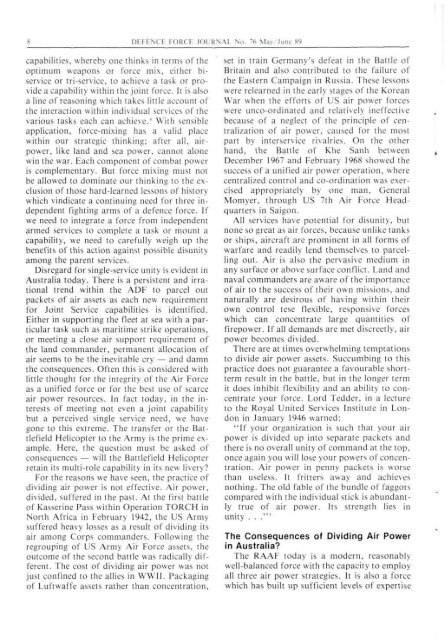ISSUE 76 : May/Jun - 1989 - Australian Defence Force Journal
ISSUE 76 : May/Jun - 1989 - Australian Defence Force Journal
ISSUE 76 : May/Jun - 1989 - Australian Defence Force Journal
- No tags were found...
You also want an ePaper? Increase the reach of your titles
YUMPU automatically turns print PDFs into web optimized ePapers that Google loves.
8 DEFENCE FORCE JOURNAL No. <strong>76</strong> <strong>May</strong>/<strong>Jun</strong>e 89capabilities, whereby one thinks in terms of theoptimum weapons or force mix, either biserviceor tri-service, to achieve a task or providea capability within the joint force. It is alsoa line of reasoning which takes little account ofthe interaction within individual services of thevarious tasks each can achieve. 4 With sensibleapplication, force-mixing has a valid placewithin our strategic thinking; after all, airpower,like land and sea power, cannot alonewin the war. Each component of combat poweris complementary. But force mixing must notbe allowed to dominate our thinking to the exclusionof those hard-learned lessons of historywhich vindicate a continuing need for three independentfighting arms of a defence force. Ifwe need to integrate a force from independentarmed services to complete a task or mount acapability, we need to carefully weigh up thebenefits of this action against possible disunityamong the parent services.Disregard for single-service unity is evident inAustralia today. There is a persistent and irrationaltrend within the ADF to parcel outpackets of air assets as each new requirementfor Joint Service capabilities is identified.Either in supporting the fleet at sea with a particulartask such as maritime strike operations,or meeting a close air support requirement ofthe land commander, permanent allocation ofair seems to be the inevitable cry — and damnthe consequences. Often this is considered withlittle thought for the integrity of the Air <strong>Force</strong>as a unified force or for the best use of scarceair power resources. In fact today, in the interestsof meeting not even a joint capabilitybut a perceived single service need, we havegone to this extreme. The transfer or the BattlefieldHelicopter to the Army is the prime example.Here, the question must be asked ofconsequences — will the Battlefield Helicopterretain its multi-role capability in its new livery?For the reasons we have seen, the practice ofdividing air power is not effective. Air power,divided, suffered in the past. At the first battleof Kasserine Pass within Operation TORCH inNorth Africa in February 1942, the US Armysuffered heavy losses as a result of dividing itsair among Corps commanders. Following theregrouping of US Army Air <strong>Force</strong> assets, theoutcome of the second battle was radically different.The cost of dividing air power was notjust confined to the allies in WWII. Packagingof Luftwaffe assets rather than concentration,set in train Germany's defeat in the Battle ofBritain and also contributed to the failure ofthe Eastern Campaign in Russia. These lessonswere relearned in the early stages of the KoreanWar when the efforts of US air power forceswere unco-ordinated and relatively ineffectivebecause of a neglect of the principle of centralizationof air power, caused for the mostpart by interservice rivalries. On the otherhand, the Battle of Khe Sanh betweenDecember 1967 and February 1968 showed thesuccess of a unified air power operation, wherecentralized control and co-ordination was exercisedappropriately by one man, GeneralMomyer, through US 7th Air <strong>Force</strong> Headquartersin Saigon.All services have potential for disunity, butnone so great as air forces, because unlike tanksor ships, aircraft are prominent in all forms ofwarfare and readily lend themselves to parcellingout. Air is also the pervasive medium inany surface or above surface conflict. Land andnaval commanders are aware of the importanceof air to the success of their own missions, andnaturally are desirous of having within theirown control tese flexible, responsive forceswhich can concentrate large quantities offirepower. If all demands are met discreetly, airpower becomes divided.There are at times overwhelming temptationsto divide air power assets. Succumbing to thispractice does not guarantee a favourable shorttermresult in the battle, but in the longer termit does inhibit flexibility and an ability to concentrateyour force. Lord Tedder, in a lectureto the Royal United Services Institute in Londonin January 1946 warned:"If your organization is such that your airpower is divided up into separate packets andthere is no overall unity of command at the top,once again you will lose your powers of concentration.Air power in penny packets is worsethan useless. It fritters away and achievesnothing. The old fable of the bundle of faggotscompared with the individual stick is abundantlytrue of air power. Its strength lies inunity . . .'"The Consequences of Dividing Air Powerin Australia?The RAAF today is a modern, reasonablywell-balanced force with the capacity to employall three air power strategies. It is also a forcewhich has built up sufficient levels of expertise
















